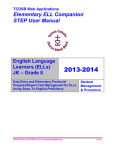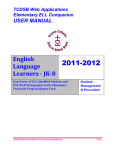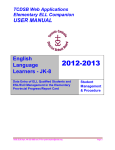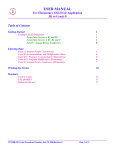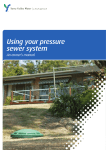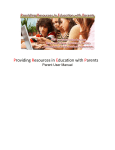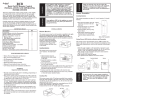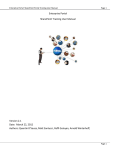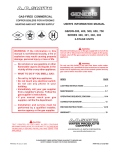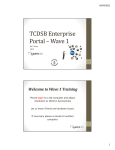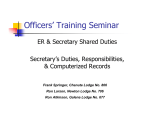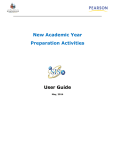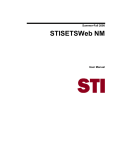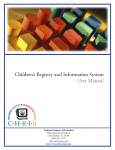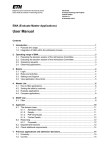Download ELL
Transcript
TCDSB Web Applications Elementary ELL Companion STEP User Manual English Language Learners (ELLs) JK – Grade 8 2014-2015 Data Entry and Elementary Provincial Progress/Report Card Management for ELLs Using Steps To English Proficiency ©ESL/ELD Dept, 416 222-8282 ext 2715 or [email protected] Student Management & Procedure Page 1 USER MANUAL ELL Companion and the Provincial Elementary Report Cards Step Version 1.5 November 2014 Table of Contents General Overview of Reporting for ELLs pg 3 Background to Step Continuum vs Stages pg 4 Accessing the ELL Companion in Trillium pg 5 Entering Student Data pg 6 Elementary ELL Student Tracking Form pg 9 Who is on the ELL Student List? How and when do I use the ELL Student Tracking Form pg 9 Section A - Student Demographic Information pg 11 Section B - Special Student Information pg 11 Section C – Initial Assessment pg 11 Section D - ELL Program Descriptors pg 12 Section E - ELL Program Accommodations, Modifications & Assessment pg 13 Secondary Placement pg 13 Section F - Student Strengths, Needs & Next Steps pg 13 Section G - Mathematics Program pg 14 Parental/Guardian Communication pg 14 Printing & Saving ELL Class Lists pg 15 The Provincial Progress & Report Card Link pg 15 Report Card Subjects & Check-Boxes pg 17 To Search for Other Students Not Listed pg 18 Help and Manuals pg 19 Elementary ELL Student Tracking Form pg 20 ©TCDSB ESL Forms & Procedures, Tuesday, January 27, 2015 Page 2 of 22 USER MANUAL ELL Companion and the Provincial Elementary Report Cards Step Version 1.5 November 2014 General Overview of Reporting for ELLs For All Elementary ELL Students All TCDSB English language learners (ELLs) should have the following information entered for three data fields in the ELL Companion application each year. This data will need to be updated as student status changes throughout the year. 1. Program Model: Intensive, Tutorial, Integrated, Comprehensive Literacy or Demit (Please refer to page 39 in the Elementary ESL/ELD Curriculum for program models.) http://www.edu.gov.on.ca/eng/document/esleldprograms/esleldprograms.pdf 2. Program Type - ESL or ELD: select whichever category is appropriate 3. Step Level : select from Steps 1 - 6 The information selected will carry forward to the Elementary Progress & Report Cards for all students who are ELL qualified. Therefore, it is imperative that all TCDSB elementary schools input the required data accurately for all JK–grade 8 ELL qualified students in order for this information to display correctly on the web based report card applications. The identification of an English language learner as being at either Step 1 or 2 indicates that the curriculum expectations for that student have been modified and the student’s mark or grade reflects the student’s level of achievement in the modified program. In such cases, the ESL/ELD box will be checked on the student’s Progress and Report Cards for the following subjects: Language (each strand for Provincial Report), Mathematics (each strand for Provincial Report), Science and Technology, and Social Studies (Geography and History for Grades 7 and 8). As well, the following statement appears on each report (located within each progress and report card. Teachers do not have to type it in): Achievement is based on expectations modified from the curriculum expectations for the grade to support English language learning needs. The identification of an ELL as being from Step Levels 3 to 6 indicates that the curriculum expectations for the ELL student have been accommodated only. In such cases, students will not have the ESL/ELD boxes checked in any subject. The default then will check the ESL/ELD boxes for Step level 1 & 2 ELLs but not for Step level 3 - 6 ELL students. The system, however, is not always perfect, so teachers always have the option to add or delete the ESL/ELD check boxes for any student manually. See the section Report Card Subjects page 16 for more information. ©TCDSB ESL Forms & Procedures, Tuesday, January 27, 2015 Page 3 of 22 USER MANUAL ELL Companion and the Provincial Elementary Report Cards Step Version 1.5 November 2014 Background to 6 Step Continuum vs old 4 Stages The Ministry continues to release components of the new Step Steps To English Proficiency http://www.edugains.ca/newsite/ell2/step/stepflowchart.html resource materials for English language learners from grades 1 to 12. Step was developed as “a resource to provide a framework for assessing and monitoring the language acquisition and literacy development of all English language learners across the Ontario curriculum.” Step provides revised language acquisition descriptors that recognizes the length of time necessary for developing academic English proficiency (an average of up to six years), and Step also gives teachers the necessary tools, including initial and ongoing assessment materials, and math assessments for each grade. These tools are made available on ELL Gains http://www.edugains.ca/newsite/ell2/index.html, as well as the initial elementary math assessments http://www.edugains.ca/newsite/ell2/initialassesselementary.php (which are password protected to help maintain the tests’ integrity). To date, the Ministry through the ELL Gains web site has released: - The Initial Language Assessment Continua, http://www.edugains.ca/newsite/ell2/step/initiallanguageassessment.html, grades 1-12 (Oral Communication – listening and speaking, Reading, Writing), and the Initial Language Assessment password protected content at http://www.edugains.ca/newsite/ell2/initiallanguageassessmentappend.php. (NOTE: TCDSB ELL teachers should contact the TCDSB ELL Department for our confidential board provided login and password. - Steps to English Proficiency: A Guide for Users http://www.edugains.ca/resourcesELL/Assessment/STEP/STEPUserGuide_January2 012.pdf - Ongoing Classroom Assessment Continua – ESL, http://www.edugains.ca/newsite/ell2/step/observablelanguagebehaviour.html, grades 1-12 (Reading, Writing, and Oral Communication) - The Ongoing Classroom Assessment Continua for ELD will arrive soon, as well as the Examples of Evidence (concrete and curriculum-specific examples to illustrate learning behaviours), Initial Secondary Math Assessments, and exemplars for the different grades and levels. The Elementary ELL Companion has been revised to reflect the Step levels. The 6-level Step model that replaces the old 4-stage model for ESL is shown in comparison in the chart below: ESL STEP Level ESL Stage Levels 1 2 1 2 3 4 3 5 6 4 ©TCDSB ESL Forms & Procedures, Tuesday, January 27, 2015 Page 4 of 22 USER MANUAL ELL Companion and the Provincial Elementary Report Cards Step Version 1.5 November 2014 The Step elementary ELD Reading and Writing programs are still comprised of 4 Steps which maintains the same language acquisition sequence and levels as the previous 4Stage model. Students who complete ELD Step 4 should advance to ESL Step 4. Accessing The English Language Learner (ELL) Companion in Trillium Access the Intranet - Web Applications via your Elementary teacher link, or simply enter 'Intranet’ in the "address bar” at the top of the school’s internet screen, or from home at https://secure.tcdsb.org/dana-na/auth/url_default/welcome.cgi. Under Applications, click Web Applications and then TCDSB Web Applications Under All School Apps, click on the English Language Learner (ELL) Companion. Note: The system displays a “Login” screen for the application. If access is denied please contact Eva Au at 416 222-8282 extension 2417or the Help Desk ([email protected] or ext. 4357) to request access. ©TCDSB ESL Forms & Procedures, Tuesday, January 27, 2015 Page 5 of 22 USER MANUAL ELL Companion and the Provincial Elementary Report Cards Step Version 1.5 November 2014 Enter your User ID and your Password and click Login. If your Login is successful, the Elementary ELL Companion application menu is displayed. Under User Profile, Check the year, and if you teach ESL/ELD in more than one school remember to change your location here. To change your User Profile (School, and School Year or effective date), click on User Profile tab as indicated in the diagrams. It may be useful to access previous years’ ESL/ELD Forms by selecting earlier School Years. Entering Student Data The ELL Students List contains all JK-8 students in your school who meet the Ministry criteria for English Language Learners (currently, foreign-born and arrived within the past 6 years to Canada). Although ELLs are only funded for 4 years, the ministry recognizes that many other English language learners may require focused educational supports for longer. English Language Learners Policies and Procedures, K-12, 2007, Section 2.8.1, p. 8. Under Student Management, click the ELL Student List. You must enter/select the Program Model (Intensive, Tutorial, Integrated or Comprehensive Literacy - Please refer to the Elementary ESL/ELD Curriciulum, 2008, for program models, page 39 http://www.edu.gov.on.ca/eng/document/esleldprograms/esleldprograms.pdf), Program type (ESL or ELD) and ESL/ELD Step level (1, 2, 3, 4, 5 or 6) for all of these ELL Students. All 3 fields must be completed for each student before the program will allow you to Save & Submit for all three categories, otherwise the application will flag this as an error ©TCDSB ESL Forms & Procedures, Tuesday, January 27, 2015 Page 6 of 22 USER MANUAL ELL Companion and the Provincial Elementary Report Cards Step Version 1.5 November 2014 and the data will not be saved. All English Language Learners (ELLs) should be assessed as to their English proficiency level and appropriate Program Model prior to entering the information. This information may be obtained from the elementary assessment instrument materials available from the ELL Gains web site at http://www.edugains.ca/newsite/ell2/step/stepflowchart.html. ELL Students are defined by the Ministry. See Elementary ELL Student Tracking Form pgs 8-9 for more specific details. Under Student Management, click ELL Student List. Teachers can sort by any category along the top by clicking here in the box labels, i.e. Class, Birth Date, etc. If any ELL students do not appear under this list (such as Canadian born ELLs), refer to page 17 for how to locate and report on them using the Search Students tab. Double-click on Program Model space adjacent to the student to activate the drop down list. Do the same for all three fields for each student in this list. 1. Program Model – Double-click in the student space to select the applicable program model (Intensive, Tutorial, Integrated, Comprehensive Literacy or Demit) for each student. Please refer to the Elementary ESL/ELD Curriciulum, 2008 for program models, page 39, http://www.edu.gov.on.ca/eng/document/esleldprograms/esleldprograms.pdf. Note: All primary ELL students from JK to Grade 3 should be categorized under the ‘Comprehensive Literacy’ (formerly Balanced Literacy) program model. While not specifically defined in ministry literature, most ELLs would follow these guidelines: Intensive for Step level 1-2 students, Tutorial for Step level 3-4 students, and Integrated for Step level 5-6 students. We would not normally use Demit for an ELL student unless they have moved or are ‘Inactive’; ‘Demitted’ ELLs will not be counted in the ELL Student List of total numbers - see page 16 for more details. ©TCDSB ESL Forms & Procedures, Tuesday, January 27, 2015 Page 7 of 22 USER MANUAL ELL Companion and the Provincial Elementary Report Cards Step Version 1.5 November 2014 2. Program Type- Double-click on the ESL/ELD space to activate the drop down list and select either ESL or ELD whichever applies to the student. For more information on the difference between the two programs consult the Elementary ESL/ELD Currciulum, at http://www.edu.gov.on.ca/eng/document/esleldprograms/esleldprograms.pdf. 5. Double-click on the ESL/ELD Step level space to activate the drop down list and select the correct Step level (1 - 6) that applies to the student. Note: Remember to repeat this procedure for all ELLs on the ELL Student List. 3. Step Level – Using the Step Initial Assessment materials (available on line at ELL Gains, http://www.edugains.ca/newsite/ell2/step/initiallanguageassessment.html) and the TCDSB Step Assessment Summaries (by division), ELL teachers should select a Step for each English language learner. If the student straddles several Step levels, teachers should select the lower possible number (which is usually the student’s reading and writing levels, although not always). Verify that you have all 3 entries for each ELL student, and when complete click the Save &Submit button to save and input the data. Save &Submit after each student! The application will return an error message if any field is not complete and will not allow saving for multiple students – do each student separately. This information then feeds into Trillium and the Report Card application. . Note: To access other English language learners (such as Canadian-born students) you must use the Search tab. See page 17 for details. School administrators should ensure all students in the ELL Student List have these three fields updated correctly and completely by mid-February each year. This is crucial to help ensure appropriate staffing of ELL teachers at schools for the fall. ©TCDSB ESL Forms & Procedures, Tuesday, January 27, 2015 Page 8 of 22 USER MANUAL ELL Companion and the Provincial Elementary Report Cards Step Version 1.5 November 2014 Enter information for each student separately. Once these 3 fields are complete for all ELL listed students, the information is automatically updated into Trillium and the Progress/Report Card system. To add or delete the ESL/ELD check boxes on the Report Cards refer to the Report Card Subjects & Check-Boxes further in this manual. Elementary ELL Student Tracking Form If any of these ELL listed students do not receive ESL/ELD programming then it is not necessary to complete the Elementary ELL Student Tracking Form, only the three essential fields for these students. Changes can be done at any time during the year if student information changes. The English Language Learners (ELL) Program Policies and Procedures K-12 document (http://www.edu.gov.on.ca/eng/document/esleldprograms/esleldprograms.pdf) stipulates that all qualified ELL students must be tracked and reported upon each year. This helps inform the Ministry through the board’s annual OnSIS report, and helps provide TCDSB with information regarding ELL student population data by school level. Who is on the ELL Student List? Under Ministry regulations, all elementary school-age children in the province from JK to grade 8 who meet the following criteria would be considered ‘qualified’ as English As a Second Language or English Literacy Development program students and the board would receive appropriate funding for them: 1. Students born in a non-English speaking country; 2. Students who have recently arrived in Canada (within the past 5 years, currently students who have arrived since September 1, 2007 will appear on the list); 3. Students whose Registration data has been correctly entered into the Trillium system by the school secretary. English language learners such as Canadian-born students who speak another language at home are not found on this list, however, they should not be disqualified from receiving support in either the ESL or ELD program if they are deemed to require it. Students such as these may need focused English language support in an ESL or ELD program. Schools should ensure the ELL teacher therefore includes them in the program should they need it, and for tracking purposes uses the Search Students tab in the ELL Companion to report upon their progress. See page 17 for how to locate and report on these students. How and when do I use the ELL Student Tracking form? ELL teachers, school administrators or designated staff where ELL teachers are not located, should record and track ELL student progress on the Elementary ELL Student Tracking Form. If any ELL listed students do not receive direct ESL/ELD programming ©TCDSB ESL Forms & Procedures, Tuesday, January 27, 2015 Page 9 of 22 USER MANUAL ELL Companion and the Provincial Elementary Report Cards Step Version 1.5 November 2014 then it is not necessary to complete the Elementary ELL Student Tracking Form; only the three essential fields for each of these students on the ELL Student List. Changes can be done at any time during the year if student information changes. Deleting? If a Tracking Form was previously completed for the student the information will carry over from last year. Delete this information and update the form with current information by typing in or using the drop-down descriptors. The tracking form is to be completed at the beginning of the school year after each English language learner has been assessed as to their proficiency in English. (ELL Gains has all the Initial Assessment materials at http://www.edugains.ca/newsite/ell2/step/initiallanguageassessment.html. Contact the ELL Department for password protected components). As well, the form is to be completed at the end of the school year and an Annual Review meeting should take place between the ELL teacher and a school administrator, and a final copy put in the OSR. The form can also be updated throughout the year if changes in student status occur, or if the student moves. A final version of the form should be included in each student’s OSR at the end of June. This form is to be completed for each English language learner who receives instruction in an ESL and/or ELD program. It is to be done in addition to the student Report card. It is also advisable that ELL teachers save an electronic copy of each completed form labelled by student name in a separate ELL file labelled for each year. To Save the form select Print, and Save As a PDF file. Please note that TCDSB practice is typically to provide ESL or ELD program support to students in grades 4 to 8 in elementary school. This is due to the level of support currently available to help develop primary student literacy through the Comprehensive Literacy (formerly the Balanced Literacy) program. If you have any questions in this regards, please contact your school’s Literacy Resource Teacher. The tracking form is dynamic - text boxes will expand as needed, so the form may change in length as information is input. When printing, the form may print out over several pages. Many boxes contain dropdown menu items to help teachers in selecting the appropriate comments for each student’s program. Teachers always have the option to modify, delete parts, or simply add your own comments within the boxes. Spell Check is also enabled to ensure accuracy. Section A Student Demographic Information When the school secretary inputs each ELL student’s registration information into Trillium, it will automatically feed into this form as well as the student progress/report card. It is crucial that ELL teachers check this information to ensure its accuracy which can help avoid later corrections to the system. Only the school secretary may access Trillium if changes are needed to the student’s information. ©TCDSB ESL Forms & Procedures, Tuesday, January 27, 2015 Page 10 of 22 USER MANUAL ELL Companion and the Provincial Elementary Report Cards Step Version 1.5 November 2014 Date defaults to today’s current date when you open the application to denote when data was entered onto the form, although date may be changed using the dropdown menu. There are also two other dropdown menu buttons, one to note the ELL Teacher and the other for any Other Teachers who are responsible for student programming, for instance the Special Education teacher if the student has an IEP. ELL teachers will also need to determine the student’s ability to Read and Write in their Native Language(s) and check the appropriate boxes if applicable. A sample of student writing in first language should also be obtained for inclusion in the student’s OSR. Program defaults to current date. To change, use dropdown menu. Determine the student’s ability to read and write in their dominant language and check the boxes if applicable. Save & Submit often. Section B Special Student Information This section of the form is reserved for any information pertinent to the student’s academic or social success in school. It is important to note any special student needs, interests or relevant personal or family information. Remember, only you as ESL/ELD teacher and your administrator can access these forms so all information is strictly confidential. There is a maximum of 5000 characters and Spell Check enabled. Section C Initial Assessment Using the Step Initial Assessment materials (available on line at ELL Gains, http://www.edugains.ca/newsite/ell2/step/initiallanguageassessment.html) ELL teachers are to assess each ELL and indicate the student’s Step level and proficiency in Reading, Writing, Oral Communication and Mathematics. If the student straddles several Step levels, teachers should select the lower possible number (which is usually the student’s reading and writing levels, although not always). Teachers then use the dropdown boxes to indicate the appropriate Step level descriptors. Classroom teachers should also be consulted regarding assessing the student’s mathematical abilities within the different strands, but assessment should focus primarily on skills in Number Sense and Numeration . ©TCDSB ESL Forms & Procedures, Tuesday, January 27, 2015 Page 11 of 22 USER MANUAL ELL Companion and the Provincial Elementary Report Cards Step Version 1.5 November 2014 There is a maximum of 240 characters allowed in each box. Section D ESL/ELD Program Descriptors See Steps To English Proficiency descriptors in the areas of Oral Communication (speaking and listening), Reading, Writing and Orientation. These Observable Language Behaviours are available for input with a simple point-and-click from the drop down menu button. Select those that are most appropriate to the student’s ESL/ELD program. Step Observable Language Behaviours can be viewed on line at the Ministry’s ELL Gains at http://www.edugains.ca/newsite/ell2/step/observablelanguagebehaviour.html. Click the “trees” to expand the menu items. Set the appropriate Step Level for each skill area. Save & Submit after completing each box. Teachers reporting on ELD students should use the Oral field to comment on ELD Oral Expression and Language Knowledge. Any supported Kindergarten students would need comments to be manually input for each box in this section. There is a maximum of 240 characters within each box and Spell Check. Click the level under the appropriate division to drop down the descriptors, then click ‘Select’ to copy each descriptor comment into the Form. When complete, click the “Copy Selected Comments…” bar above to add the comments into the box. Do the same for each of the 4 areas. Save & Submit after completing the box for each skill area. ©TCDSB ESL Forms & Procedures, Tuesday, January 27, 2015 Page 12 of 22 USER MANUAL ELL Companion and the Provincial Elementary Report Cards Step Version 1.5 November 2014 Section E ESL/ELD Program - Accommodation, Modification & Assessment Strategies This box details teaching strategies appropriate for this each student’s ESL/ELD program. Students in Step levels 1 and 2 would require program modifications to be noted, while all students including those in Step levels 3 - 6 should have suitable comments noted regarding program accommodations. All students should have a description of the most appropriate assessment strategies noted for them as well. All descriptors can be input by pointing-and-clicking from the dropdown menu button and copying to the Tracking Form. Teachers may alter, delete, or add to these comment boxes as well. There is a maximum of 2000 characters within each box with Spell Check. Please note that only students in the ESL/ELD program at Step levels 1 or 2 will have the check boxes highlighted for the major subject areas. Please review the section on Report Card Subjects & Check-Boxes further in this manual for more information. Select the appropriate accommodations or modification using the “trees” as required, then select suitable assessment strategies from the drop down menu as well. Save & Submit after each box. The boxes will fit up to 2000 characters. Linked here are the Secondary ESL/ELD Curriculum Document and the Secondary Transition Guide to help direct teachers in the meetings. Secondary Placement – This section is intended for the Exchange of Information meeting that takes place each spring between elementary and secondary teachers to discuss Grade 8 ELL student needs and appropriate secondary placement. Teachers should complete this prior to the Review meeting, selecting Designation (ESL or ELD), Program Model (Intensive, Partial, Tutorial, or Demit), and Course Level (A-E). Teachers are advised to first review the secondary ESL/ELD curriculum at: http://www.edu.gov.on.ca/eng/curriculum/secondary/esl912currb.pdf for more information, and see the Transition Information Guide (available in Help for printing). Save & Submit for each student after completing this section. Section F Student Strengths, Needs & Next Steps This section is intended to be completed at June end and is primarily for classroom teachers to note any student attributes that merit programming considerations. These could include recording any demonstrated strengths the student exhibits, perceived needs, and suggested next steps for more effective instruction or assessment. The ELL teacher will need to contact the classroom teachers of all students that they support to gather this information before the end of June and then manually input it. ©TCDSB ESL Forms & Procedures, Tuesday, January 27, 2015 Page 13 of 22 USER MANUAL ELL Companion and the Provincial Elementary Report Cards Step Version 1.5 November 2014 The box will expand to fit up to 2000 characters and Spell Check is enabled. Section G Mathematics Program This area of the form will automatically fill in all mathematics grades/marks and comments from the latest term of the student Report Card. ELL teachers may “Refresh” with the latest recorded information if required (from the previous term or year) using the Refresh Math Marks & Comments button. There is a maximum of 5000 characters; once the Report Card is complete, comments can be Refreshed for this box. Parental/Guardian Communication While the need for ongoing communication with parents/guardians is critical especially in the ESL/ELD program, schools are not required to divulge any of the information contained in the ELL Student Tracking Form as per regulations 2.8.1 and 2.8.4 of the ELL Policies and Procedures document http://www.edu.gov.on.ca/eng/document/esleldprograms/esleldprograms.pdf. Administrators may, however, request a parental/guardian signature to indicate that the parents or guardians have been advised of the contents of the form if they so wish. This is especially relevant if the administrator wishes to have an end-of-year Review Meeting involving the ELL teacher and with the parent/guardians’ involvement. We do not need parental permission in order to program for ELL students, however, parents/guardians are expected to be advised of appropriate program modifications in place through regular reporting. Parent/Guardian Signature appears only when the form is printed. After saving and submitting the completed form, ELL teachers are advised to save individual electronic copies of each student’s form in an appropriately named ELL school file (such as ESL Students 2014-15). Save under each student’s name and list by time of year, such as ‘Consaco, Jose - Spring 2015’ to differentiate it from the fall form. ©TCDSB ESL Forms & Procedures, Tuesday, January 27, 2015 Page 14 of 22 USER MANUAL ELL Companion and the Provincial Elementary Report Cards Step Version 1.5 November 2014 Printing & Saving ELL Class Lists ELL teachers have the option of printing two student lists from the Companion: All ELL Student List (up to 6 years) – This includes all ‘qualified’ ELL students in the school although it is understood that not all of these students need or necessarily receive ESL/ELD program support. All students should have the three fields in the ELL Student List completed for them, however, regardless of program support. All Supported Students List – These are the students who are actually supported in an ESL/ELD program, and who have progress reported upon in the ELL Student Tracking Form. It is not required that all students be on the school’s ELL Student List in order to receive support (such as the case with some Canadian born ELL students). In order to print out either of these class lists, first click the Reports tab. Then choose the format of the list you require, either in Adobe PDF form (non-changeable) or Microsoft Excel (spreadsheet form). These lists are not changeable while open in the Reports tab. Note: If you receive a message, “pop-up may be blocked by Google tool bar”, hold down the Ctrl key while clicking on the list name again. Click the format required, select the list you need, then click Print under File. It may be beneficial to Save a copy of the list each term for your records as well. The Provincial Progress & Report Card Link The ELL Companion has been revised to reflect Ministry of Education Policy, as outlined in section 2.8.2 in the ELL Policies and Procedures document, regarding when to check off the ESL/ESD box on the newly revised Provincial report card. The following statement comes from page 27 of the document: http://www.edu.gov.on.ca/eng/document/esleldprograms/esleldprograms.pdf ©TCDSB ESL Forms & Procedures, Tuesday, January 27, 2015 Page 15 of 22 USER MANUAL ELL Companion and the Provincial Elementary Report Cards Step Version 1.5 November 2014 In grades 1-8, the identification of a student as being at either Step level 1 or 2 indicates that the curriculum expectations for the ELL student have been modified and the student’s mark or grade reflects the student’s level of achievement in the modified program. In such cases, the ESL/ELD box will be checked on the student’s Progress and Report Cards for the following subjects: Language (each strand for Provincial reports), Mathematics (each strand for Provincial reports), Science and Technology, and Social Studies (Geography and History for Grades 7 and 8). As well, the following statement appears on each report (located within each progress and report card. Teachers do not have to type it in): Achievement is based on expectations modified from the curriculum expectations for the grade to support English language learning needs. Information should be noted on the report indicating the nature and extent of the program adaptations. In grades 1-8, the identification of a student as being from Step levels 3 to 6 indicates that the curriculum expectations for the ESL/ELD student have been accommodated only. In such cases, students will not have the ESL/ELD box checked in any subject. * These check boxes may be manually changed in individual cases, where warranted, through the Report Card Subjects tab (see following). * Note that any ELL student who has their Program Model listed as Demit and Step 6 will not have any indicator box checked; however teachers are advised to avoid demitting any student as this may affect the ELL teacher allocations. Contact the ELL Department for further details. ©TCDSB ESL Forms & Procedures, Tuesday, January 27, 2015 Page 16 of 22 USER MANUAL ELL Companion and the Provincial Elementary Report Cards Step Version 1.5 November 2014 Report Card Subjects and ESL/ELD Check-Boxes Click Action This changes to Save afterwards After logging into the ELL Companion click on the Report Card Subjects tab (under Student Management) to access student information for report card check-box changes. By clicking on the Edit icon (‘paper/pencil’) under the Action column for any student, teachers can access a dropdown menu to make any necessary changes to a student’s Program Model, ESL/ELD designation and/or ESL/ELD Step level. Always Save & Submit any changes after each student. Students highlighted in orange are simply to indicate that they are outside the funding period of four years. They are still entitled to receive ESL and/or ELD program support if required, and if so would need their ELL Student Tracking Forms completed. These students may still receive ESL/ELD programming if teachers feel it is necessary. Students highlighted in orange are simply to indicate that they are outside the funding period of four years. To check on or change individual student information pertaining to the Report Card check boxes, when in the Report Card Subjects view, click on a student’s name to access their information, as illustrated on the screen following: ©TCDSB ESL Forms & Procedures, Tuesday, January 27, 2015 Page 17 of 22 USER MANUAL ELL Companion and the Provincial Elementary Report Cards Step Version 1.5 November 2014 The ELL Student Tracking Form can also be opened directly from this screen. The activated check boxes are automated. You may activate or deactivate as necessary by clicking directly in them. Remember only Step level 1 and 2 ELLs should have these boxes checked. Pull the scroll bar down to access check boxes for Terms 1 and 2. (It may be necessary to expand the box by grabbing and dragging the corner) All English Language learners (whether qualified or non-qualified) who are designated as either Step level 1 or 2 will default to receiving a check mark for each report in Language (each strand for Provincial reports), Mathematics (each strand for Provincial reports), Science and Technology, and Social Studies (Geography and History for Grades 7 and 8). The ESL/ELD indicator boxes will be checked and the Ministry statement pertaining to program modifications will apply (already located on each of the progress and provincial report cards). The indicator check box can be removed or added for any subject by clicking on the appropriate check box. Once a student’s level is initially recorded, this will be the default rule for populating the report card; any changes made to the student’s level after the Progress Report will not be automatically reflected in subsequent reports. Therefore, entering this correctly early in the school year will ensure all of the students reports are accurate and will avoid having to make corrections in later report cards. Once you enter data for an ELL student through Report Card Subjects tab, the student can always be found again in the same list, and the student’s ELL Student Tracking Form can be opened in this view. Non listed ELLs can be found using Search and once information is recorded for them once, their name will appear on the ELL Student List. To Search For Any Other Student Not Listed To access any other student not found in the ELL Student List, users must use the Search Students tab. To Search, you have three options shown below: ©TCDSB ESL Forms & Procedures, Tuesday, January 27, 2015 Page 18 of 22 USER MANUAL ELL Companion and the Provincial Elementary Report Cards Step Version 1.5 November 2014 1. Enter Student Last Name: you need only the first few letters of the last name. OR 2. Enter Student First Name: you need only the first few letters of the first name. OR 3. Enter any Grade: you need to include the two-digit grade (04, 05, 06, etc.) 4. Click on . When the search returns, click on the correct student’s name and follow the instructions from the previous section Report Card Subjects &Check-Boxes, or see Entering Student Data for inputting the three essential fields for ELL reporting purposes. 6. If the student’s name has not appeared, check for correct spelling or check if the student is registered in Trillium with a different last name. 7. Even if you have previously entered data on an ESL/ELD student, you will still have to access the student’s name through the Search function if you wish to update information on the ELL Student Tracking Form. 8. In order to have any changes you’ve made in the ELL Companion (ESL/ELD Check-boxes, level, etc) reflected in the student’s Progress or Report Card immediately, please have your Report Card administrator go to School Setup, Student Information while in the Progress/Report Card application. Click on the Grade, then select the Student. Use the green arrows to input the name onto the right hand side and simply click Refresh Students Information button. When the Progress/Report Card is opened the new information will be present. Help and Manuals Use Help tab to access a PDF copy of the Elementary ELL Step Companion Manual See the Secondary Step Transition Guide for important information on elementary ELL secondary course placement. The Step Assessment Summaries for each division may be accessed here as well. If you have any trouble with the ELL Companion application, contact Eva Au X2417, or the Help Desk at 416 222-8282 extension 4357. ©TCDSB ESL Forms & Procedures, Tuesday, January 27, 2015 Page 19 of 22 USER MANUAL ELL Companion and the Provincial Elementary Report Cards Step Version 1.5 November 2014 Elementary ELL Student Tracking Form The next two pages outlines the Elementary ELL Student Tracking Form all ELL teachers are responsible for completing for each ELL student receiving support in an ESL and/or ELD program. Forms are completed twice each year: - Once at the beginning or when the student first arrives including the Student Information, Initial Assessment (reading, writing, oral and math), the ESL/ELD Observable Language Behaviour Continua (program descriptors in reading, writing, oral, orientation – learning skills), and the ESL/ELD Programming Considerations (teaching and assessment strategies) boxes are completed; - Again at the end of the year. All previous boxes are updated in addition to the Student Strengths, Needs and Next Steps box (with classroom teacher input), and the Mathematics Program box is refreshed with the most up to date information. This form may be printed earler in the spring for the grade 8 Exchange of Information meetings. The final copy of the completed form is printed and included in each student’s OSR in June. ©TCDSB ESL Forms & Procedures, Tuesday, January 27, 2015 Page 20 of 22 USER MANUAL ELL Companion and the Provincial Elementary Report Cards Step Version 1.5 November 2014 Elementary ELL Student Tracking Form TO BE COMPLETED AT BEGINNING & END OF EACH SCHOOL YEAR - INCLUDE IN OSR School Student Name Arrival Date in Canada Native Language(s) Designation (ESL or ELD) Classroom Teacher Principal/Designate Date Sex DOB Grade Country of Birth Reading in L1 Y/N Writing in L1 Y/N Program Model Step level (1-6) ELL Teacher Other(s) Student Information Record special needs (physical or learning exceptionalities, social or emotional issues), special interests (aptitudes, abilities, skills), medical or educational services, immigration status or other family information, etc Initial Assessment Reading Step Writing Step Oral Communication Step Math Step ESL/ELD Observable Language Behaviour Continua Reading Step Writing Oral Communication Step Step Orientation (Learning Skills) ©TCDSB ESL Forms & Procedures, Tuesday, January 27, 2015 Page 21 of 22 USER MANUAL ELL Companion and the Provincial Elementary Report Cards Step Version 1.5 November 2014 ESL/EL Programming Considerations Teaching Strategies – “The student may benefit from the following program Accommodations accommodations:” Teaching Strategies – Modifications “The student may benefit from the following program modifications:” Assessment Strategies “The student may benefit from the following assessment strategies:” Secondary placement “Recommended Secondary ESL/ELD course placement:” Includes suggested Program Model Designation (ESL or ELD) Program Model, Level (A-E) Student Strengths, Needs and Next Steps ESL Teacher comments plus contributions from other teachers Note strengths observed in regular subjects Mathematics Program Grade Number Sense & Numeration Automatically inputs most current math comments and grades Measurement Geometry & Spatial Sense Patterning & Algebra Data Management & Probability Parent/Guardian Signature:_________________________ Date:___________ (Optional area) ©TCDSB ESL Forms & Procedures, Tuesday, January 27, 2015 Page 22 of 22






















